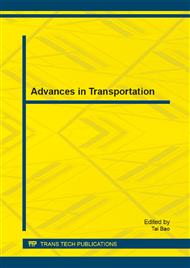p.798
p.805
p.809
p.813
p.820
p.827
p.832
p.840
p.845
A Two-Step Method to Solve the Motor Train-Set Circulation Problem
Abstract:
This paper deals with the optimization problem of motor train-set in dedicated passenger line, a motor train-set operational model was proposed and maintenance constraint was considered . To solve this model and utilize the motor train-set efficiently, we described a two-step method and the problem was divided into two sub-problems: one is to make sub-routings and another is to combine these sub-routings to new circulations. First step the Hungarian algorithm was used to get circulations of the motor train-set without considering maintenance constraint and the circulations will be divided into several sub-routings by the constraint of maintenance. In order to utilize the motor train-set more balanced, the second step is to combine these sub-routing to new circulations by path exchange rules. This approach was evaluated on the Jing-Hu Passenger Dedicated Line, the computational results show that this new method is feasible and we provide a new idea to solve such problems.
Info:
Periodical:
Pages:
820-826
Citation:
Online since:
January 2014
Authors:
Price:
Сopyright:
© 2014 Trans Tech Publications Ltd. All Rights Reserved
Share:
Citation:


